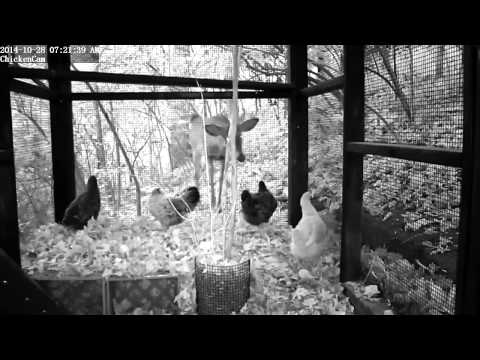I wanted to get some chickens a few years ago and bought the plans for TheGardenCoop.com . I then went down to the county permit office and discovered they didn't really want me to put a coop on my property. So after thinking about it for a while, I decided to go ahead and just build it anyway. My back yard has about a half acre of un-landscaped forest and isn't fenced. I picked a spot in the middle for the coop that'll be hidden from my neighbor's view for most of the year. Unfortunately, it'll be visible during the winter so I'll have to come up with someway of hiding it when all the leaves drop off the trees.
The basic GardenCoop is roughly a 6'x9.5' covered run with a 3'x5' coop. I'm expanding it slightly to 6'x12' and adding on some external nesting boxes to the coop. I'm hoping to have enough room for about 7-8 chickens.
Another twist to this is there isn't a flat spot in my yard. The coop will be on a slope. Here's looking downhill on the spot I picked.

And this is looking at it uphill.

The foundation will be solid concrete blocks.

I had to dig down into the slope to make a level spot for it. The uphill side of the coop has the blocks on their side 4" deep.

The downhill side has a mound of gravel covered with some hardware cloth and two layers of blocks. I ended up needing a lot more blocks and gravel than I originally thought.

I've kept some of the small trees that were already growing in the middle of the run for now. I know the chickens will probably tear them up but maybe I can protect them.

The basic pieces of the frame went together fairly quickly using the garden coop plans. I picked a dark color to paint it that matches the trim on my house. It's called "Dark Forest" and hope it'll help hide the coop in the trees.

Here's my painting crew at work.

This is the frame on the block foundation. Yea! Unfortunately, I had to make a few adjustments to the frame after I discovered that I didn't make the foundation wide enough by 4".

The basic GardenCoop is roughly a 6'x9.5' covered run with a 3'x5' coop. I'm expanding it slightly to 6'x12' and adding on some external nesting boxes to the coop. I'm hoping to have enough room for about 7-8 chickens.
Another twist to this is there isn't a flat spot in my yard. The coop will be on a slope. Here's looking downhill on the spot I picked.
And this is looking at it uphill.
The foundation will be solid concrete blocks.
I had to dig down into the slope to make a level spot for it. The uphill side of the coop has the blocks on their side 4" deep.
The downhill side has a mound of gravel covered with some hardware cloth and two layers of blocks. I ended up needing a lot more blocks and gravel than I originally thought.
I've kept some of the small trees that were already growing in the middle of the run for now. I know the chickens will probably tear them up but maybe I can protect them.
The basic pieces of the frame went together fairly quickly using the garden coop plans. I picked a dark color to paint it that matches the trim on my house. It's called "Dark Forest" and hope it'll help hide the coop in the trees.
Here's my painting crew at work.
This is the frame on the block foundation. Yea! Unfortunately, I had to make a few adjustments to the frame after I discovered that I didn't make the foundation wide enough by 4".

